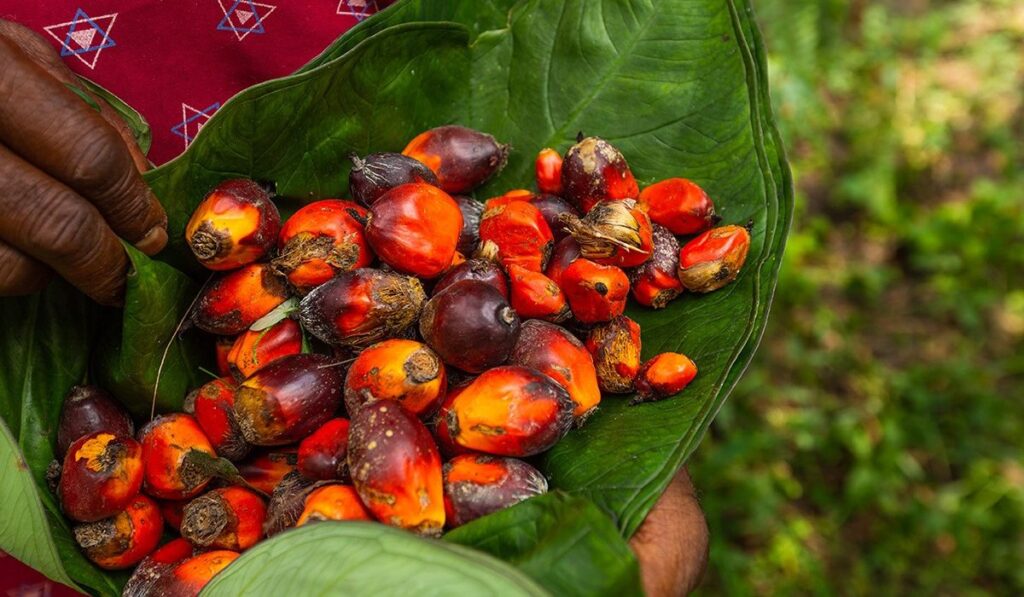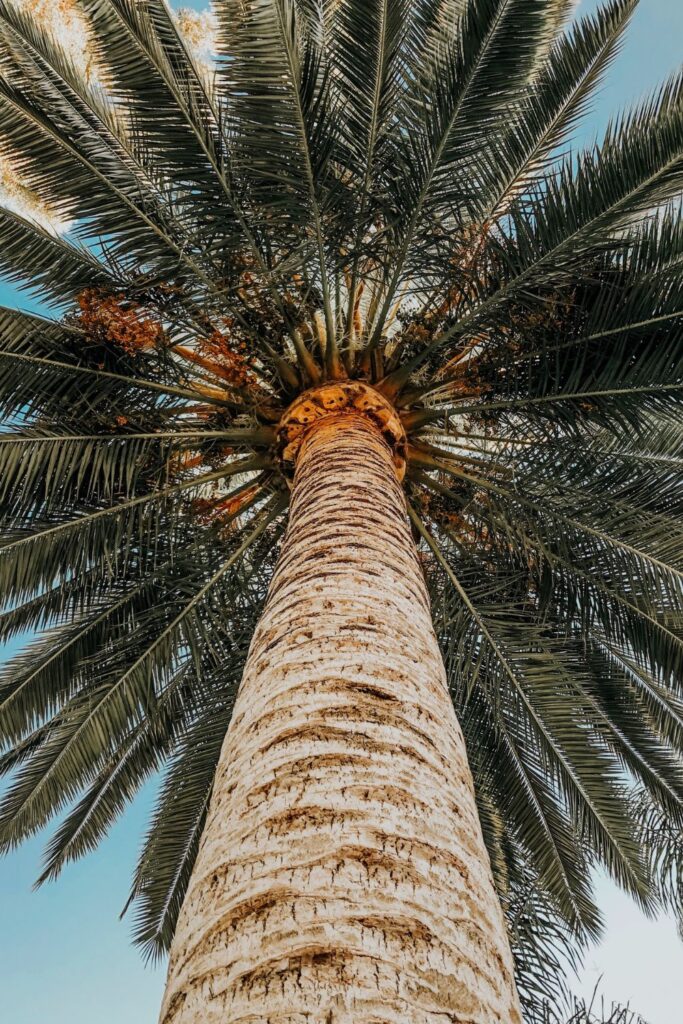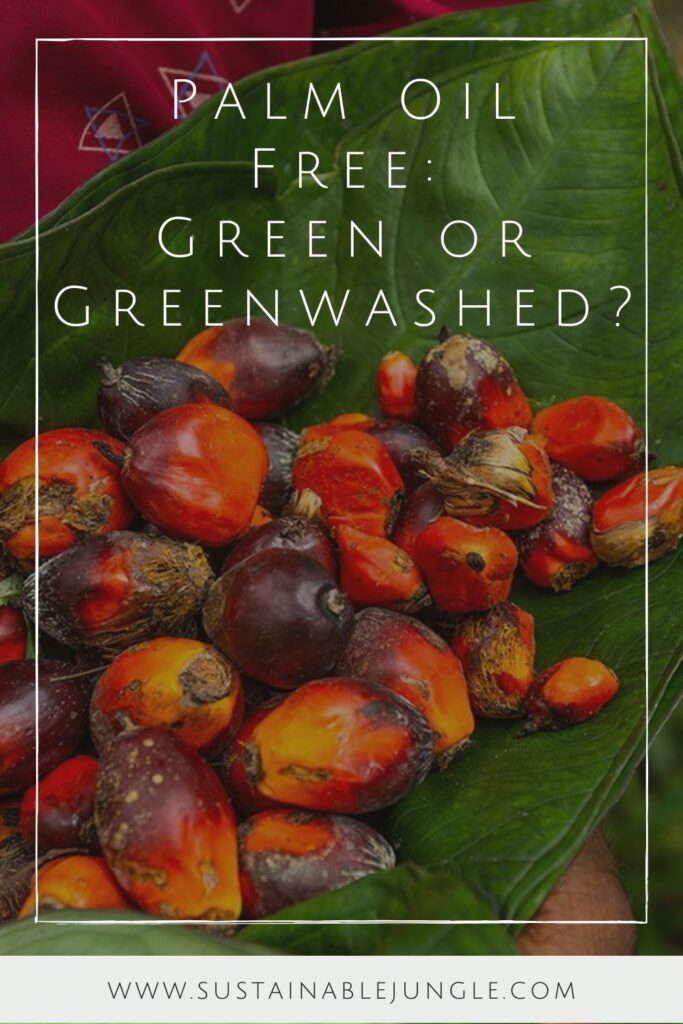
Palm Oil Free: Green Or Greenwashing?
While palm oil itself is a translucent, brilliant orange-red color, its ethics are gray.
For years, the world believed that palm oil production was unsustainable.
However, many academics, journalists, and companies have changed course.
Which has made us reevaluate our initial thoughts on whether you should buy palm oil free products.
With sustainable palm oil becoming increasingly more available and trustworthy, we’re revisiting the complex subject, this time wondering if palm oil free is everything we think it is.
Or is sustainable palm oil an acceptable ingredient in our favorite products?
QUICK LINKS TO SHOULD WE BUY PALM OIL FREE?
1. WHY IS PALM OIL SUCH A PRIZED OIL?

Let’s start with a quick refresher of the palm oil debacle:
Palm oil is found in everything…
In developing countries, the beta-carotene-rich crude oil is mainly used as a nutritious cooking oil with the understanding that it might prevent vitamin A deficiency, cancer, malaria, heart disease, and other conditions.
In the Western world, palm oil is used in detergents, cosmetics, biofuel, and food.
You could expect to find it, or one of its many derivatives, in more than half of all packaged products.
… because it can serve a lot of purposes.
Palm oil can make ice cream creamier. It makes “no-stir” peanut butter possible. It can make shampoo produce that foaming lather we’ve come to expect.
Naturally resistant to oxidation, it can seriously extend the shelf life of our favorite food products.
It also has one of the highest smoke points among oils, making it perfect for frying.
Palm oil is unique in that it’s the only vegetable oil that contains an almost 50/50 ratio of saturated and unsaturated fatty acids.
Growing oil palms is far more efficient than other crops.
Palm oil is incredibly productive, being cheaper to produce than other vegetable oils and offering a greater yield.
It also requires fewer pesticides and fertilizers than other vegetable crops by a large margin.
Palm oil is good (generally speaking) for the people who grow it.
Once yields start coming from palm oil, they keep coming.
A farmer can profit from his palm oil trees for more than 25 years, with fruits available for harvest every year, all year. This provides a permanent source of livelihood, unlike other seasonal vegetable crops.
While there’s no shortage of labor abuses, there’s no doubt that millions of smallholder farmers rely on the palm tree.
In Indonesia, smallholders manage more than 40% of plantations. By 2030, around 60% of the country’s palm oil will come from smallholder farmers.
For these often-Indigenous communities, palm oil has been the main source of income. It has lifted many out of poverty and it’s expected to continue doing so.
2. WHAT’S THE PROBLEM WITH PALM OIL?

Palm oil thrives where nature also thrives (or used to).
Palm oil grows around the equator, which is also home to many biodiverse-rich rainforests that are cleared to make room for palm oil plantations.
Not only does this compromise the survival of many unique animal species—orangutans especially, who have become the fuzzy orange poster-face of the anti-palm movement—but it also results in a huge amount of greenhouse gas emissions.
Clearing for new plantations emits around 499.9 MtCO2 per year—or the equivalent of the total carbon emissions from fuel combustion in countries like Saudi Arabia and Malaysia.
Demand for palm oil will grow.
Today, the world consumes 70 million metric tons of palm oil annually. By 2050, demand is expected to more than double.
Sure, palm oil makes modern luxuries like oat milk what it is, but can the world handle increased levels of deforestation, biodiversity loss, GHGs, and labor crimes?
Could we stand to lose 40% of all threatened mammal, bird, and amphibian species?
The answer seems to be a resounding “no”, even before considering the human animals who are also adversely impacted by the palm oil industry.
Palm oil and politics go hand in hand.
Along with other food price increases that have come with the multiple crises of recent years, palm oil is getting pricier.
While this may bring about a shift to other vegetable oils for wealthier consumers, it’ll leave those who need the oil most high and dry.
Palm oil is the cheapest cooking oil, which makes it an essential for those in poorer nations.
In Indonesia, the world’s largest palm oil producer (generating roughly 60%), every single household relies on palm oil.
Now prices are surging, in large part due to the politically powerful Indonesian palm oil businesses.
It might be a stretch to link our favorite lipstick and the actions of palm oil barons, but supporting the industry (even “sustainable palm oil”) may put more power in the hands of those who are actively contributing to rising food costs—and the collapses, coups, and wars that might follow.
3. IS THERE A PALM OIL ALTERNATIVE?

As a silver lining, the consistently rising prices are keeping palm oil production in check.
Over the past decade or so, plantation expansion has been slowing down in Indonesia, as well as other palm oil-producing countries like Malaysia.
But this good news comes with some potentially bad news.
Palm oil’s potential substitution with genetically-modified crops.
Faced with increasing prices and global palm oil acreage that remains relatively consistent, big palm oil buyers (looking at you, Unilever) have started to explore alternatives.
Biotechnology companies are also seeking alternatives, which is why one, Calyxt Inc., is working with an Asian palm oil producer to develop a gene-edited soy crop.
They join many others in an effort to create bioengineered palm oil. While it will have many of the same properties as palm oil, can this be scaled in a meaningful way?
If it does, will we just be replacing one terrible thing with another?
Even if this proves sustainable and successful, it may well put money in the hands of biotech giants in the Global North and take it away from those depending on palm oil for their livelihoods in Asia, Africa, and Central America.
Existing vegetable oils just don’t match up.
Even meeting demand with (natural) oil crops could have a worse impact on our planet.
A 2020 study was one of the first to investigate replacements for palm oil but their findings paint a complex picture.
To replicate palm oil’s unique lipid profile, other vegetable oils could be hydrogenated—but this produces trans-fatty acids that are harmful to human health.
Alternatives like rapeseed or sunflower are also associated with a poor mouth-feel and texture.
In cosmetics, reformulation is necessary to transform these other oils into something that has a fatty acid profile similar to palm oil’s.
Essentially, to emulate the behavior and consistency of palm oil, large research and development efforts (and the cost associated with it) are needed.
We’d need a lot more land for these alternatives, too.
While tropical oils (coconut and babassu) have similar fatty acid profiles, they thrive in the same region as palm oil.
To be cultivated at a similar level would result in much higher carbon emissions and even more severe impacts on biodiversity.
In one hectare, palm oil is at least twice as productive as coconut oil. Compared with rapeseed, soybean, or jojoba oil, it’s up to 10 times as productive.
Compared with the significantly more expensive Shea butter, one hectare produces 5,950 liters of palm oil and just 0.035 of Shea butter.
As such, replacing palm oil with, say, soybean oil or peanut oil could be associated with still higher levels of greenhouse gas emissions and biodiversity loss.
Rapeseed and sunflower oil also require more fertilizer than palm oil.
From that 2020 study’s authors themselves:
“Based on the findings of these life cycle assessment (LCA) studies, there is no clear-cut argument for an optimal palm oil replacement using alternative terrestrial oils from an environmental perspective.”
4. THE CASE FOR SUSTAINABLE PALM OIL

Palm oil is difficult to replace, especially in food and oleochemical applications (i.e. palm oil derivatives found in cleaning products, cosmetics, etc.).
There’s neither an economic nor environmental incentive to substitute palm oil with other oils—especially on as large a scale as is required.
Unless we go the route of lab-created single-cell oils (which come with its own set of concerns), the only option is to ensure more sustainable palm oil production.
In the short to medium term especially, sustainable palm oil seems to be the most promising solution.
Be wary of greenwashing with palm oil free claims.
Everyone is out to make a profit—including brands touting “palm oil free” products.
As Inke van der Sluijs of Roundtable on Sustainable Palm Oil (RSPO) said in an interview with Food Navigator, “Moving away from palm oil is not solving anything,” and companies boycotting palm oil are doing so as “a cheap marketing trick.”
Similarly, an Italian consumer rights organization argued that when palm oil is removed from a product’s formulation, it results in foods that have higher levels of saturated fat—with no sustainability improvements.
With food specifically, “palm oil free” came about at a time when the market was relatively inactive, so there was much to gain financially from the movement.
While palm oil free products were originally a good solution to save the orangutans and prevent smoky slash-and-burn fires, there might be a better option.
Celebrate (and encourage) palm oil’s shifts towards sustainability.
In 2014, many of the largest palm oil refiners adopted No Deforestation, No Peat, No Exploitation (NDPE) policies.
In the years following, nearly all large palm oil companies followed suit.
Along with these NDPE policies comes increased supply chain transparency.
By 2020, 83% of refineries in Indonesia and Malaysia were backed by NDPE policies—meaning the majority of palm oil is no longer linked to deforestation.
In other areas of the world, African and Afro-descendant communities have demonstrated that small-scale and even regenerative agricultural systems can be used to produce palm oil.
Truly sustainable palm oil is possible, and there are efforts to make it more widespread.
RSPO, MSPO, and ISPO, oh my.
At best, the Roundtable on Sustainable Palm Oil (RSPO) is a work in progress, but the certification body has made improvements, with increasingly stringent standards to show for it.
Environmental NGOs like Conservation International support RSPO palm oil, in part because it’s associated with 20% lower biodiversity and 35% lower global warming impacts than its non-certified counterpart.
While RSPO’s successes aren’t exactly something to shout from the rooftops, similar schemes have emerged, also demonstrating small victories.
In 2020, the Indonesian government listened to environmental and social activists by requiring smallholder farmers to be certified under the Indonesian Sustainable Palm Oil (ISPO) scheme, which protects against deforestation, land disputes, and labor rights abuses.
They will all have to comply by 2025, which should bring an area larger than Switzerland under sustainable cultivation.
More impressively, Malaysia is bringing about a “green palm oil revolution” through state efforts to ensure growers are 100% sustainable by that same year.
The certification efforts will help all growers—small and large—all while improving farming practices, ending labor abuses, and resolving land disputes. It even aims to protect forests which, if successful, would be an improvement on the failings of the current trio of forestry certifications.
The country has already banned the conversion of carbon-rich peatland and primary forests to plantation and has a cap on planted areas (no more than 6.5 million hectares in 2023).
Currently, Indonesia and Malaysia have 27% and 88% of their total palm planted areas covered by ISPO and MSPO certification, respectively.
5. WHAT WE CAN DO TO ENCOURAGE SUSTAINABLE PALM OIL

Shop palm oil free.
Given how pervasive palm-containing products are, avoiding palm oil altogether is a lofty and unlikely goal for most people, which is also why avoiding it whenever possible still seems to be one of the best things we can do for our planet and the species who inhabit it.
With food especially, cutting our consumption of palm oil-containing processed foods can go a way to supporting our planet (and health).
When it comes to things like palm oil free shampoo and palm oil free toothpaste we can curb our consumption in relatively easy ways.
However, recognize that “palm oil free” isn’t the end all be all and we should take note of what brands use in lieu of palm oil.
Often, it will be coconut oil (or its derivatives), which has been associated with up to 5 times more biodiversity loss than its red-listed, red-oil alternative.
As alternatives will come at a higher environmental cost, companies should have sound reasoning to back their use of them (read: aren’t just on the profit-making-palm-oil-free bandwagon).
Build momentum for sustainable palm oil.
The demand for palm oil isn’t going anywhere but up.
But, if we were all to switch overnight to palm oil free toothpaste made with coconut – or soy-derived oils, this could have pretty dire consequences.
The demand for sustainable palm oil needs to step in.
After its inception in 2014, RSPO certification has hovered around 19% of global palm oil. Most of this is sold to US and EU markets, where there’s increased consumer awareness.
In the two biggest markets—China and India—RSPO-certified palm oil accounts for just 3-4% of total consumption.
If demand for sustainable palm oil were to rise, it would have far-reaching implications for the entire palm oil landscape.
As it stands, roughly 80% of palm oil’s biggest buying companies cite demand for certified sustainable palm oil (CSPO) as a barrier to achieving their sustainability goals.
Of these, more than 70% report engaging in on-the-ground activities to support smallholders or implement conservation projects—yet, only half have the monitoring capabilities to ensure that sustainability and human rights protocols are actually being utilized.
While it may be hard to put our trust in these multinational corporations, support for sustainable palm oil could help to bridge this gap, ensuring transparency in these do-good efforts.
If we continue to create a demand for sustainable palm oil, it will have a market.
If we don’t, some of the world’s biggest importers—who often turn a blind eye to sustainability—will continue to fuel the industry (and we really can’t let this happen).
Buy less (of everything).
Ultimately, palm oil can be considered the poster child for a cry to consume less.
The oil is pretty terrible from an environmental and social standpoint, but its alternatives appear to be worse.
So the best thing we can do is reduce our consumption across the board while simultaneously choosing sustainable sourcing where we either can’t or choose not to go palm-fee.
If you can break an addiction to your favorite ice cream, do so. If you can cut one skincare product out of your routine, do that.
If you have time to make your own eco-friendly cleaning products instead of using one that contains palm oil-derived surfactants, that will help, too.
FINAL THOUGHTS ON PALM OIL CONSUMPTION
While this deep dive leaves us with more questions than answers, they’re just as valuable.
Whether you decide to go totally palm oil free, or reach out to your favorite brands to encourage them to source sustainable palm oil, we need more engagement to create positive change.
With changes in certification schemes, the past decade has shown that our pressure is working to encourage the industry to change for the better.
Experience a face-palm reaction to this ever-convoluted debate?
Us too, so we need to keep talking about palm oil.
Share this article with friends and family to help everyone stay as informed as possible when buying both palm oil free and sustainable palm oil products.




